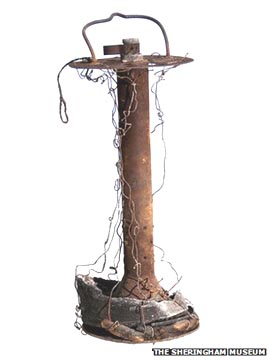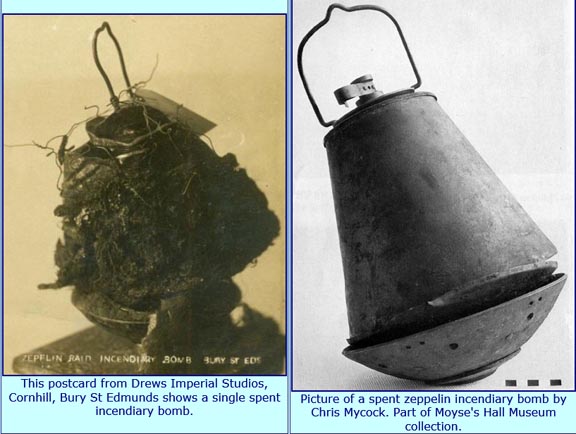
|
|
|
What's IotD? The interesting, amazing, or mind-boggling images of our days. |
|
IotD Stuff |
|
Permalink Latest Image |
|
|
|
Some folks who have noticed IotD
Neatorama |
|
Common image haunts
Astro Pic of the Day |
|
Advertising |
Jan 20th 2015: Dawn of the Air Raid
|
Dawn of the Air Raid It was the day that heralded a new type of warfare. A century ago today, Germany launched the first Zeppelin raids on Britain during the First World War. The targets, in Norfolk, were chosen by chance. The two Zeppelins were heading for Humberside, but were diverted by strong winds, so they bombed King's Lynn and Great Yarmouth. The raid left four people dead. |
Sundae Tuesday Jan 20 03:14 PM
I seem to remember the 'rents telling you at Christmas about Dad's bedroom being bombed when he was a baby.
Obviously he wasn't in it - I'm pretty much proof that he survived - but WWII is so recent in my mind.
I had one of my Brianna moments when the new Kate Atkinson came out.
Not only that I will always want to share her books with Bri, but that this one touches so much on the London of my family - the Blitz, the bombs, the women who lived and those who didn't.
I didn't know that Yarmouth (our annual holiday destination) was hit in WWI.
Thank you.
footfootfoot Tuesday Jan 20 04:03 PM
|
I seem to remember the 'rents telling you at Christmas about Dad's bedroom being bombed when he was a baby.
Obviously he wasn't in it - I'm pretty much proof that he survived - but WWII is so recent in my mind. I had one of my Brianna moments when the new Kate Atkinson came out. Not only that I will always want to share her books with Bri, but that this one touches so much on the London of my family - the Blitz, the bombs, the women who lived and those who didn't. I didn't know that Yarmouth (our annual holiday destination) was hit in WWI. Thank you. |

xoxoxoBruce Tuesday Jan 20 08:29 PM
I guess that's why the Brits were quick to organize and ship the kids out of town when WW II came along, they learned.
One bomb, which fell through the roof of a cottage, detonated in the kitchen but was grabbed by a local man and extinguished outside in a horse trough. The device forms the centrepiece of a commemorative exhibition at the Sheringham Museum opening on 1 March. |

gtown Wednesday Jan 21 12:44 AM
This was discussed in a NOVA special called "Zeppelin Terror Attack":
http://www.pbs.org/wgbh/nova/militar...or-attack.html
Some quotes from the transcript regarding the bombs:
JOHN STARLING: …rags, rope and things like that, were loaded into a cage and fired
When the bomb hit its target, the impact would have triggered the fuse and set fire to a substance called thermite, a mixture of iron oxide and aluminum that burns with a fierce heat. This, in turn, would cause a tank of benzene, a form of gasoline, to explode.
One mystery they hope to solve is why the bomb is bound in rope coated in tar; and another is how the Germans managed to get the tar on, in the first place.
xoxoxoBruce Wednesday Jan 21 01:12 AM
I would guess when the tank of benzene exploded it would scatter pieces of flaming tarred rope in all directions. If they want to tar the rope, just ask the navy, they've been doing it for centuries. 
Carruthers Wednesday Jan 21 10:31 AM
| Stem and base only, of a First World War German incendiary bomb which was dropped on the railway lines near Wallsend Station, Northumberland, on the night of 14 April 1915, by the German Naval Airship Zeppelin L9. This, the second Zeppelin raid in which bombs were dropped on England, started out as a reconnaissance flight, but when within a hundred miles of Flamborough Head, Kapitanleutenant Mathy in L9, with a good supply of bombs on board, was authorised to raid the Tyne. The L9 appeared off the mouth of the Tyne at about 7pm, and proceeded northwards to Blyth, before coming inland to raid Tyneside. The airship was met by the rifle-fire of the 1st Battalion Northern Cyclists at Cambois. Mathy's first bomb fell in a field at West Sleekburn, followed by twenty-two others before the Tyne was reached at about 8.40pm. L9 unloaded the eight remaining bombs and went out to sea south of South Shields. The only casualties occurred at Wallsend, where a woman and a child were injured. Note that the first German airship raid on Great Britain took place on the night of 19/20 January 1915, when Zeppelins L3 and L4 dropped bombs on East Anglia, and casualties were sustained in Great Yarmouth and King's Lynn. |
| First World War period incendiary bomb dropped on railway lines near Wallsend Station, Northumberland, on the night of 14th April, 1915 by German Naval airship L.9 in the course of the second Zeppelin raid in which bombs were dropped on England. |
| Bomb remnant of German incendiary bomb, comprising stem and base only (H 53cm x 18cm diameter). |
xoxoxoBruce Wednesday Jan 21 12:09 PM
OK, the museum calls it a "German incendiary bomb", that would support my theory of the burning tarred rope pieces scattered from the explosion.
The picture Carruthers used in the op looks like explosion damage rather than fire razed, to my eye. I wonder if they had more than one kind of bomb?
From here,
| In 20 minutes a Zeppelin had dropped 3,000 pounds of bombs, 91 incendiaries that had started 40 fires, gutted buildings and left seven people dead. Not a single shot was fired in retaliation. From that day forward the Zeppelins were known as the "baby killers". |
| During their brief, but deadly dominance the airships killed more than 500 people and injured more than a thousand in places all down the east of the country. The last ever attempt to bomb Britain by a Zeppelin was over the Norfolk coast on 5 August 1918. Three years earlier, when a Zeppelin first appeared in the skies above Great Yarmouth, it was an invincible force, but now they were outclassed and dealt with swiftly. |

|
But the Zeppelin exposed those at home who were now as vulnerable as those on the front line. The government became acutely aware they needed an aerial defence system that operated in depth. It led to the formation of the RAF in 1918 and to the development of operations rooms such as the one at Duxford that proved so crucial in 1940 during the Battle of Britain and ultimately victory in World War Two. |
Carruthers Wednesday Jan 21 12:30 PM
| I wonder if they had more than one kind of bomb? |

| The local police force made this collection of the spent incendiary bombs dropped on Bury St Edmunds in April, 1915. Also a few pieces of explosive bombs. |
The Great War of 1914 to 1918 Picture Gallery of Bury St Edmunds and surrounds
xoxoxoBruce Wednesday Jan 21 12:53 PM
Excellent, Sir, that explains the apparent explosive damage.
However  that link shows incendiary bombs pretty intact, so I figured they were extinguished before finishing their mission.
that link shows incendiary bombs pretty intact, so I figured they were extinguished before finishing their mission.
Then I saw this...

That shoots down my theory of the exploding Benzene tank scattering burning pieces of tarred rope.
mrputter Wednesday Jan 21 02:05 PMI see what you did there!
gtown Wednesday Jan 21 03:13 PM
From the NOVA special their tests (which are just that, not the true recipe of course) result in this:
NARRATOR: As Peter predicted, the raging thermite immediately causes the benzene to explode in a fireball, but what's surprising is that the bomb is still burning 15 minutes later, thanks to the tarred rope.
PETER NORTON: We thought the rope would add a burning effect, but it's quite surprising how much time it'll just continue to burn away and use up the fuel that's provided by the tar.
JOHN STARLING: That rope is actually a critical component to the bomb. You want to actually sustain the temperature to set fire to wood, the buildings, et cetera. If you drop enough of them, you'll overload the emergency services, and things like that, so incendiary is actually far worse, in some ways, than high explosives. You see things burning. It's more of a terror weapon.
xoxoxoBruce Wednesday Jan 21 03:26 PM
| PETER NORTON: We thought the rope would add a burning effect, but it's quite surprising how much time it'll just continue to burn away and use up the fuel that's provided by the tar. |

footfootfoot Thursday Jan 22 01:12 PM
I was thinking it was like the wick of an oil lamp.
|
Your reply here?
The Cellar Image of the Day is just a section of a larger web community: a bunch of interesting folks talking about everything. Add your two cents to IotD by joining the Cellar. |


